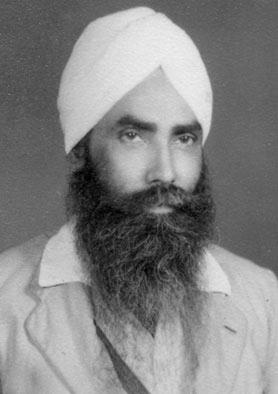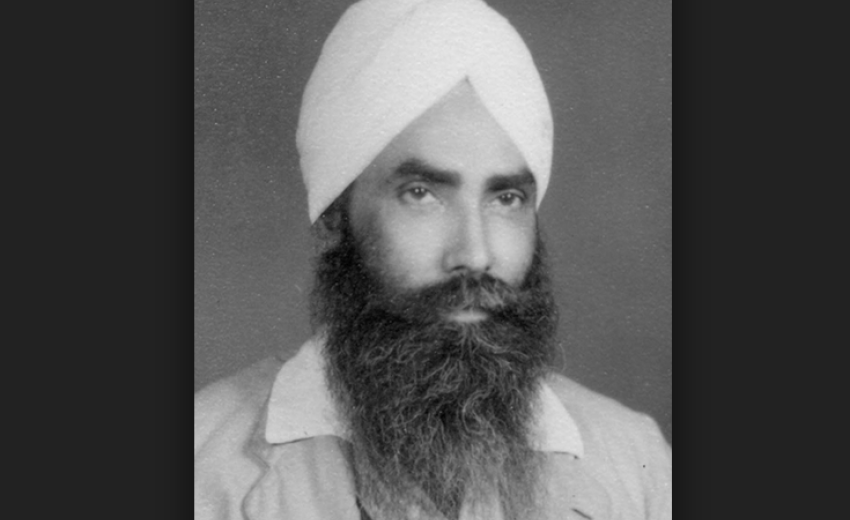 Amongst the Gursikh Kirtania Parcharaks of Malaysia, Giani Harchand
Singh ji Bassian is remembered with great affection by many elderly
members of sangats in Raub, Kuala Lumpur, Klang, Seremban, Malacca,
Taiping, Ipoh, Tapah, Penang and many other Malaysian towns.
Amongst the Gursikh Kirtania Parcharaks of Malaysia, Giani Harchand
Singh ji Bassian is remembered with great affection by many elderly
members of sangats in Raub, Kuala Lumpur, Klang, Seremban, Malacca,
Taiping, Ipoh, Tapah, Penang and many other Malaysian towns. He was appointed the first government funded Panjabi school teacher in Malaysia (at Raub, Pahang in 1948). He was also a gifted kirtania. He sang shabads with parmans in puratan reets i.e. traditional kirtan with relevant quotations from Gurbani, in a most meditative manner. In his younger days, he was a dhadi, singer of epics from Sikh history called parsangs and vaars in traditional style and was renowned for his powerful inspiring renditions (inherited by his youngest son, the world renowned Dya Singh of Australia). He was a robust parcharak of main stream Sikhi tradition.
Slim and tall, Giani Ji had a charismatic personality and a spiritual presence. It was due to his strong spiritual leaning from childhood that he became a Gurbani teacher and a kirtania parcharak, despite his family background as a village lambardar (headman) from a farming Dhaliwal family.
He was born on 25 September 1909 at his mother’s (nanakay) Village Mitthewal in District Sangrur, the only son of Modan Singh, a Dhaliwal lambardar of village Bassian near Raikot in Ludhiana. His father passed away when young Harchand Singh was only four years old and he also lost his mother within 6 months. He was taken to his mother’s village Mitthewal to be brought up by his maternal grandparents.
His Mama Ji, Nand Singh of Indian National Army, recalled when Giani Ji passed away in 1975 at Ludhiana in Panjab,, “He was agile and played village games but remained aloof. Even from a very young age his interest was in education. He would go to the local dera of an old holy man (sant). He would do small chores for him and would learn Gurmukhi and listen to Vedic folklore and about sakhis of Guru Sahibs. He even learnt how to blow the conch shell which the sant kept. We would joke about his interest in learning, not realizing his Gurbani mission in life.”
Giani ji was invited to Malaya by his Chacha Ji, Munshi Isher Singh Bassian in 1929. He was in Malaya for four years from 1929 to 1932. During this period he was a student of Giani Chanan Singh at Kuala Lumpur.
On returning to Panjab, he was married to Harminder Kaur, daughter of a Grewal farmer of Village
 Dhandra in District Ludhiana, on 15 June
1933. He settled down in his village Bassian after marriage. He took
possession of his land and lambardari of Dhaliwals and built a house to
raise his family. However, his quest for learning took him to Khalsa
Updeshak College at Damdama Sahib, Sabo Ki Talwandi, where he studied
Gurmat from April 1934 to 1936. He was 27 years on leaving this
institution.
Dhandra in District Ludhiana, on 15 June
1933. He settled down in his village Bassian after marriage. He took
possession of his land and lambardari of Dhaliwals and built a house to
raise his family. However, his quest for learning took him to Khalsa
Updeshak College at Damdama Sahib, Sabo Ki Talwandi, where he studied
Gurmat from April 1934 to 1936. He was 27 years on leaving this
institution.He joined the rasala (horseguards) of the Maharaja of Kutch and lived at the town of Bhuj from 1 May 1937 to 1 September 1939. On return to Punjab, he became popular in the area as a Kirtania parcharak and stayed in the company of saintly Gursikhs like Baba Nand of Kleran. He also picked up Kirtan sung in the popular dhunis of the sant tradition during this period. This was the Kirtan which later so endeared him to the older generation in Malaysia.
When the World War II broke out, Giani Ji enlisted at the military workshop at Ambala Cantonment in 1942, where he met S. Lakhmi Singh who headed the military technical college. S. Lakhmi Singh, who later worked as Headmaster, Government Technical School, Ferozepur City after the war, was a rasia (meditative listener) of Gurbani kirtan and was very much impressed by Giani ji’s Kirtan. He ensured that the latter was not sent to the front but remained behind to do kirtan and granthi sewa at the historical Gurdwara Badshahi Baag, Ambala, first built by Sikh military cadets of Ambala Cantt. Giani ji did seva there from 5 July 1942 to 1 August 1947.
Soon after the war, he was invited to Malaysia by the sangat of Raub, Pahang to teach Panjabi at the school attached to the Gurdwara Sahib. The sizeable sangat of Raub at the time not only included first migrant elderly Gursikhs but also educated next generation Gursikhs like Babu Santa Singh, his brother Gurbachan Singh, Master Gurmukh Singh, some police officers and others, who had managed to get Government recognition and funding for Punjabi teaching at the Punjabi school. Giani Ji left with his family for Malaya by train from Ludhiana on 31 December 1947 and reached Penang on 20 January 1948. The family reached Raub on 24 January 1948.and he took over as Punjabi teacher at the school and as Kirtania Granthi at the Gurudwara Sahib. He began to be invited to do kirtan and to sing parsangs (traditional poetic stories of great Sikh martyrs and heroes) at Gurdwaras in Kuala Lumpur, Seremban. Klang and Kuala quite regularly.
He visited India from 10 April 1953 to 24 August 1953, and soon afterwards, due mainly to Gurdwara politics by new generation committee, left Raub after 6 years seva, to move to Klang. It is a sad reflection on Sikh affairs that from about mid- fifties, Gurdwara politics and infighting amongst factions continue to deprive future Sikh generations of Gurbani kirtanias and kathakars of the highest calibre. Disappointed with lack of respect for religious personnel, Giani Ji, tried to bring up his growing family by first working as a bus conductor at Klang (1954), then as a shopkeeper at Taiping (1955). However, despite mismanagement of Gurdwaras, his demand amongst sangats as kirtania parcharak continued to grow. Baba Sohan Singh Ji of Malacca gave great encouragement and leading scholars and gianis would drop in at home to see how he was getting on.
Once a group of prominent personalities came to see the family when he was working as a bus conductor at Klang and lived in a derelict wooden hut with mud floor surrounded by tall grass. Nevertheless, in the true Sikh spirit of chardhi kala, despite his poor health he remained cheerful and witty as usual and sangats came in large numbers to hear his Kirtan at the weekends.
He realized that his was destined to be the life of a Sikh missionary and no other. He left the family at Taiping so that his children’s education could continue uninterrupted, and, despite failing health, worked as Punjabi teacher and granthi at various Gurdwaras including Dharmak Jatha and the main Gurdwara at Penang, Tapah and finally at one or two Gurdwaras at Kuala Lumpur.
Having seen his children through school education, Giani Ji left for India in frail health towards end 1970 to live at Gurdev Nagar in Ludhiana. He passed away peacefully on Guru Nanak Sahib’s Gurpurab day on 18 November, 1975 due to enlarged heart condition.
During his married life Giani ji was supported by his dedicated wife Harminder Kaur through some very difficult times at their village Bassian and in Malaysia. She was honoured with a special article, “Bebay Ji of Bassian” in a UK Eastern Media Group publication “Shaheed Ganj” in 2005.
Of Giani ji’s four surviving children, one daugher and three sons, the eldest Sarandeep Kaur lives in California with her family; Gurmukh Singh, the eldest son retired as a First Division UK Civil Servant, Cllr Baldev Singh JP, the middle brother has been honoured for his community services in Australia, and the youngest is the Gurbani sangeetkar of global fame, Dya Singh of Australia.
[ Editor’s note: The name of Giani Harchand Singh Bassian, revered father of the world-renowned Gurbani sangeetkar, S. Dya Singh of Australia, has been mentioned in numerous articles about the latter. This article by our columnist S. Gurmukh Singh, the eldest son of Giani ji, tells us more about this remarkable Kirtania Parcharak of Malaysia.
We feel very humbled and honored that Giani Harchand Singh Bassian
Ji has left the Sikh Nation with so many memories, but above all his
doctrines have allowed all his children to continue in his footsteps as
admirable respectable Panthic individuals ]
